|
|
 |
Change of name from Bran
Buddy(-ies) to HiFi Buddy(-ies)
The
way that I came up with the name Bran Buddy/Buddies is derived from
the name of the key ingredient used in these recipes: Kellogg's
All-Bran Bran Buds—or "All Bran Bran Buds" as I often
expressed it (Kellogg's itself being the trademark owner of the All-Bran
and Bran Buds names). I have also used the Bran Buddy
expression for some other Bran-Buds-containing treats that I
have thrown together, not just these bars. But it was for good
reason that I used this kind of naming on all of these recipes.
Yes, they obviously contained bran from the Bran Buds. But they
were also very delicious—high in fiber, yet surprisingly
delectable or "decadent" (as some would say). I
somehow perceived a "nutritious and very delicious"
kind of treat like this as a "buddy"—as in friend,
pal, ally, etc.—this word being, of course, derived from
"Buds" in Bran Buds.
While I have succeeded in getting many people turned on to these
recipes that were both nutrition-friendly and taste-friendly, at
least one person suggested that I drop "Bran" from the
name, due to the likelihood of scaring off some other potential
tasters. This would pose a challenge to me, due to my having
used the "Bran Buddy" form for a few years.
But another term had been on my mind throughout those years as
well—Hi-Fi. Why?
As I was growing up, "Hi-Fi" (or "HiFi," or
"hi-fi," or "hifi") had a nice ring to it,
at least for me and many other people of my generation. Hi-Fi
was an abbreviation for High Fidelity, a term describing
high-quality audio. In more recent times, this wording has
somehow given way to "Hi-Def" or High Definition,
a term still applicable to audio, but a lot more easily
associated with video (particularly HDTV's, i.e.,
high-definition televisions, with wide, flat screens).
However, what I had in mind was the idea of "Hi-Fi"
standing for "High Fiber", at least within the
context of my Bran Buddy concoctions. So I thought that I would
change the name of my high-fiber treats to "Hi-Fi
Buddies" (or "Hi-Fi Buddy Bars"). This sounded
good to me, and I felt that it would sound good to many people
from my generation as well (hopefully in addition to those
people older than us). Many of us who grew up rockin' out to
"hi-fi stereo" systems in the 1970's would acquire a
significant desire for fiber as we got older.
But what about those younger than us? These people may not yet
be as concerned about getting enough fiber, and "Hi-Fi"
and "High Fidelity" may sound too old to them. But at
least "Hi-Fi" easily rhymes with "Wi-Fi",
which itself stands for "Wireless Fidelity" (a bonus
is that the "Fi" part still stands for
"Fidelity"), and this Internet-related term is
something that these younger ones can much more easily relate
to. So as long as the rhyme is there, perhaps "Hi-Fi"
will still have at least a somewhat decent ring with these
people too. Furthermore, even though they might not have a
particularly big appetite for fiber these days, they still may
like the high-fiber snacks anyway.
When someone hears the wording "Hi-Fi Buddies", that
may bring up images of some kind of audiophile community.
"Ah, the joys of high-end electronics!" Anyway, I have
come to conclude that switching to this new naming arrangement,
with "Hi-Fi" standing for "High Fiber" in
this context, was a good move. |
| |
WE INTERRUPT THIS RECIPE
SCRAPBOOK TO BRING YOU...
An unexpected FedEx delivery!
Okay, what happened was...on the morning of the day before my
53rd birthday, I heard sounds of what seemed to be a box
"drop" and a scanner "beep" near my front
door. Without opening this door, I simply glanced out of a
window and spotted a FedEx truck in front of my house. I
afterward took in this box, which bore an Amazon.com logo.
Before long, I was guessing this "Saturday Delivery"
package to be something from my brother (and his household) in
California. It was a good guess.
I opened the box and found three wrapped presents.
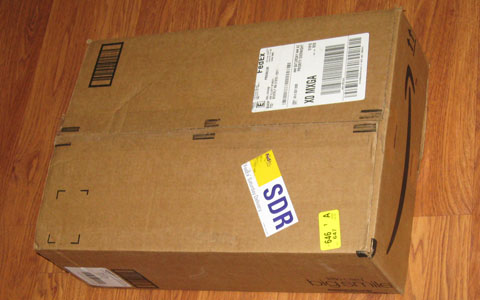
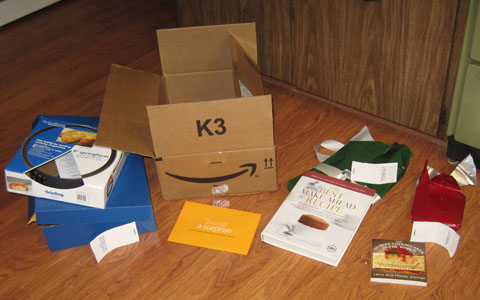
A note was attached to each wrapped item.
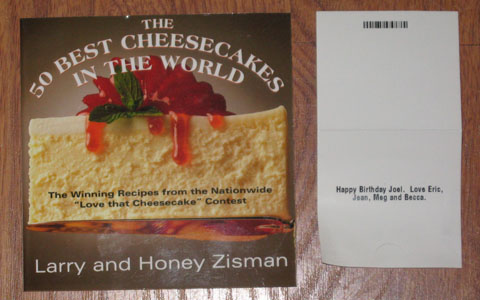
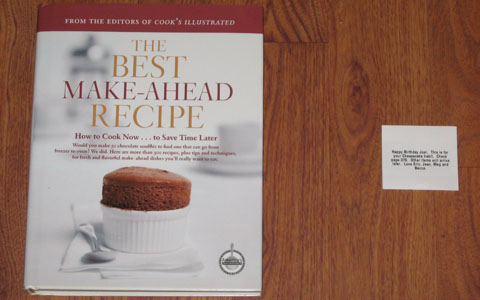
The first gift was a book, The 50 Best Cheesecakes in the
World, which came with this note: "Happy Birthday Joel.
Love Eric, Jean, Meg and Becca." (i.e., my brother, his
wife and their two daughters). The next gift was also a book, The
Best Make-Ahead Recipe, along with this note: "Happy
Birthday Joel. This is for your Cheesecake habit. Check page
370. Other items will arrive later. Love Eric, Jean, Meg and
Becca." On Page 370 itself, in addition to containing a
recipe for New York-Style Cheesecake, there was a top
recommendation for a particular springform pan—so guess what
the third gift was?
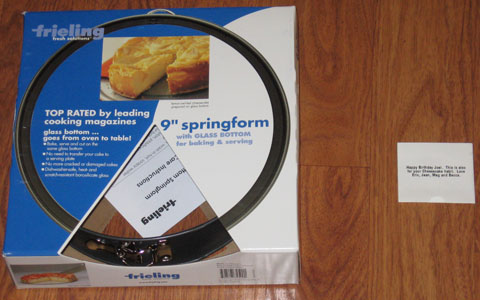
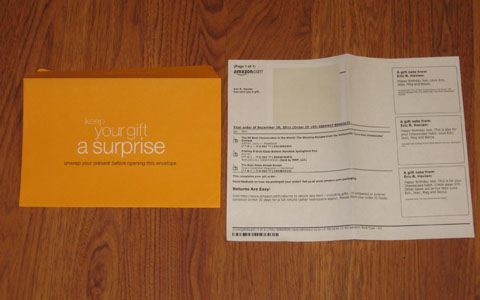
That's right! The third gift was that Page 370 endorsement, a
Frieling 9" springform pan, with—OMS (OhMySurprise)!—a
glass bottom!! Now that was certainly a different kind of
cheesecake pan! The accompanying note said, "Happy Birthday
Joel. This is also for your cheesecake habit. Love Eric, Jean,
Meg and Becca."
The Amazon package also contained an envelope which said
"keep your gift a surprise"/"unwrap your present
before opening this envelope". Figuring that following this
sequence would optimize my unpacking experience, I obediently
opened my three presents first, including reading their
respective accompanying notes. I then anticipated that the
envelope would contain some kind of follow-up message
from Eric, Jean, Meghan and Rebecca which they
would want me to read specifically after unwrapping my
presents. Actually, the envelope's contents turned out to be a
packing slip, describing the three enclosed wrapped items. But I
could still see the reason for accessing this envelope last—discover
the identity of each gift upon unwrapping it, not
upon viewing the packing slip! Okay, Amazon.com! Will do (and so
I complied)!
And so the cheesecake journey rawks on! Thank you, Eric, Jean,
Meghan and Rebecca!
And now, back to the Recipe Scrapbook! |
| |
Change of All-Bran product from Bran Buds to regular variety
For
probably about 7 years or perhaps more, I have extensively used Bran
Buds, a high-fiber cereal from Kellogg's All-Bran line, which also
contained the regular, or Original, All-Bran. It was from the Bran
Buds name that I came up with "Bran Buddies". My 21st century
recipe scrapbook was launched from delicious and nutritious food creations
that I somehow made up, using the Bran Buds product.
My food experiments have come a long way since then. In addition to my
quest to making tasty treats that were not too high in fat as well as
containing at least a decent amount of fiber, I have increasingly desired
for all the ingredients utilized to be natural.
Sometime in my earlier Bran Buddies days, the list of ingredients for the
Bran Buds product included high fructose corn syrup. Kellogg's more
recently (to my delight!) replaced it with sugar. But the list still
contained one ingredient that I regarded as an undesirable impediment to
my natural quest: BHT, or butylated hydroxytoluene, an additive
used extensively by food processors to extend freshness.
However, the regular All-Bran contained a very simple list: wheat bran,
sugar, malt flavor and salt, none of which I determined to be artificial.
While this product was also fortified with various vitamins and minerals
(probably at least some of them being "synthetic"), their
presence hardly bothered me.
I felt that the time had come for me to switch to the Original variety.
Bran Buds cereal was a reasonably good start for me. I had to give it credit
for launching this scrapbook. But as the years went by, I even phased out the
"Bran Buddies" name, replacing it with "HiFi Buddies"
at some point. And now, in June of 2013, it was time—again—to
move on.
Some trade-offs need to be noted here. The regular All-Bran (at least as
of this writing) is not as high in fiber as its Bran Buds counterpart. But
the regular version still has plenty of this nutrient. I have also felt
that this version had a somewhat better taste compared to Bran Buds. A
bonus was the Original containing much less sodium.
It is with
Prototype 5 of my orange cheesecake
(the crust, to be
more specific) that my usage of the regular All-Bran has gotten its debut
in this recipe scrapbook. Aside from disputes over added vitamins and
minerals, I now feel that, within reasonable respects, I can think of (at
least) many of my future cheesecakes as being regarded as "all
natural". |
Changes to basic cheesecake batter composition, mid-2015
When
I started making lower-fat cheesecakes back in the 1980's, I utilized
a recipe inside a cookbook from the American Heart Association. That
recipe's batter contained the following ingredients:
Lowfat cottage cheese
Margarine—which I later replaced with butter
Eggs
Granulated sugar
Skim milk
Flour
Salt
Lemon juice
Lemon rind (peel)
When I resumed making cheesecakes—which was around
2009—I was no longer using lemon peel as a base ingredient (I still
used this one for lemon cheesecakes). As the next few years went by,
I also removed lemon juice as a base ingredient, due primarily to my
starting to use a new cheese ingredient—yogurt cheese—which,
like lemon juice, had tart characteristics. I also eliminated skim milk at
some point. The salt was, somewhere along these years, removed as well. So
these changes left the following remaining "original"
ingredients:
Lowfat cottage cheese
Butter (formerly margarine)
Eggs
Granulated sugar
Flour—of which I used various types, such as whole wheat and, more
recently, unbleached all-purpose
New additions to the base ingredient list, based largely on my plain
cheesecakes, were—within the past few years:
Yogurt cheese
Vanilla
Arrowroot
The "cheese base" in particular had undergone changes. This used
to be only cottage cheese. More recently, yogurt cheese has taken over
this slot, although I would use a blend of both yogurt and cottage cheeses
for cheesecake flavors that I felt should not be highly tart. For plain
and citrus flavors, I would go solely with yogurt cheese. A cookbook from
Health Valley, Cooking Without Fat by George Mateljan, turned me on
to this ingredient as well as arrowroot.
However, after my somehow losing some satisfaction over a number of my
latest cheesecakes, including Prototype 12 of my plain-flavored ones, I
felt that another update was warranted.
I have come a long way since that initial American Heart Association
recipe. Over the last few years, I have researched a number of more
conventional, traditional, full-fat, cream-cheese-based cheesecake
recipes. What I have found was a typical, popular base set of ingredients
among them:
Cream cheese
Eggs
Granulated sugar
Vanilla
Of particular importance was that cream cheese generally contained
stabilizers and/or thickeners such as:
Xanthan gum
Locust bean gum
Guar gum
I myself tried using xanthan gum in a number of recipes, but often with
unsatisfactory results (maybe I used too much?).
Lately, I saw potential in more closely paralleling my lower-fat cheesecakes
with their higher-fat counterparts. The basic batter list that I had been
working with in recent times consisted of the following:
Yogurt cheese (sometimes also with cottage cheese)
Butter
Eggs
Granulated sugar
Flour (such as all-purpose)
Vanilla
Arrowroot
So I reasoned that eliminating the butter would bring my list more in parallel
with the conventional, higher-fat lineup. However, the two cheeses—cottage
and yogurt—did not have enough stability like typical cream cheese.
Hence this called for ingredients like all-purpose flour and arrowroot.
But I felt that instead of using both of these two items, I would go
solely with the Health-Valley-recommended arrowroot, which seemed to be a
more efficient (and hopefully better-tasting) stabilizer than all-purpose flour.
The resulting list for my new batter base would be:
Yogurt/cottage cheese
Arrowroot (to help stabilize the cheese)
Eggs
Granulated sugar
Vanilla
Compare the conventional list:
Cream cheese (with its own stabilizers)
Eggs
Granulated sugar
Vanilla
So my new composition was down to 5 simple ingredients. It was with
Prototype 13 of my plain cheesecake—the batter, to be more specific—that
my usage of this lineup has gotten its debut in this recipe scrapbook series
(I added more cooking time as well with this prototype).
I continued making changes in my plain cheesecakes by simply adding
another egg for
Prototype 14.
Not only would this return the
egg-to-cheese-base ratio to what it was in earlier days, but also
make the cheesecake more stable (hopefully) and
contribute further to simplification: 1 egg (as well as 1 tablespoon of
arrowroot) for every 8 ounces of cheese base.
However, I made a fairly bold move with
Prototype 15!
Okay, I admit that I have seeking to bake lower-fat alternatives to cream
cheese cakes. However, there were times when the cheese cultures from
the cottage and yogurt cheeses still did not seem to quite work out well
enough. So I thought that I would include at least some cream cheese
in the mix. More specifically, I decided to take a chance with Neufchatel
cheese—often referred to as "light cream cheese". Due to
the lighter nature of this cheese, the fat would not surge too much (keep
in mind that butter was no longer being used in the batter base
ingredients at this point).
With this move, Prototype 15 would actually get three kinds of
cheese—yogurt, cottage and Neufchatel (yogurt would still dominate
over the two others). The goal was to attain the right balance of sweetness,
tartness and "cheese-iness".
I wanted to ensure more firmness, so I added still more baking time as
well. |
Changes to basic cheesecake batter composition, mid-2017
My
experiencing a very delicious cheesecake from Trader Joe's back
around early June of 2017 prompted me to give further consideration to
overhauling the basics of my cheesecake recipes. The efforts began with
Prototype 17 of my plain cheesecakes
and ended with
Prototype 21.
Earlier in these updates I did a little tweaking with the crust. But the far
more important changes throughout the updates would involve the batter.
I felt that I should cut back on the tartness of the cheesecake's batter,
so I replaced half of the yogurt cheese with additional cottage cheese. In
other words, the cheese base's cottage-Neufchatel-yogurt ratio went from
1:1:4 to 3:1:2. It seemed like this helped enhance the taste somewhat, but
I still wasn't satisfied.
But the most significant change affected the stabilizer.
My cheesecake history began with what has probably been the most popular
stabilizer in baking—wheat-type flour. I used different kinds of
this flour, such as all-purpose and whole white.
As the years went by, I started bringing arrowroot on board (this
stabilizer getting its debut very likely in mid-2012), earlier to
supplement the wheat-based flour and later to replace it. It was probably
around mid-2015 when I outright retired the wheat-based flour, so the
arrowroot was on its own at that point. It seemed to have considerably
more stabilization strength compared to its wheat-oriented predecessor.
Recently, I tried a rather risky experiment. I made a cheesecake with no
stabilizer added. That was
Prototype 18.
This wasn't the first time that I had done this. I also made
Prototype 8
this way, and that one was exceptionally delicious. But it was also
exceptionally soft. But Prototype 8 contained only yogurt cheese for the
cheese base. Prototype 18, on the other hand, also contained cottage
cheese and Neufchatel cheese, and these two products already had some
stabilizers in them, particularly xanthan gum—an industrial
staple.
Fortunately, Prototype 18 was not an unstable disaster (a little sloppy,
yes, but not so runny). And its taste was really terrific, pretty much
like Prototype 8's and Trader Joe's. This outcome put arrowroot in the
crosshairs.
But what would be a superior alternative to arrowroot? I was looking for
sufficient stability, but I was also in the hunt for a really great taste,
just like I would enjoy with a more typical, fat-laden cheesecake.
The time had come to give xanthan gum—an ingredient available for retail
sale, at least in recent years from Bob's Red Mill—a try.
This stabilizer has been put to
extensive use in the food industry—and particularly in cream cheese
(often in conjunction with guar and/or locust/carob bean gum here)! But I
didn't think that xanthan gum had been embraced anywhere nearly as much in
homes. Maybe one of the reasons was the difficulty in using it. I myself
have incurred a number of failures in the past with this ingredient—often
by using too much of what I found out the hard way to be an overwhelmingly
powerful stabilizer!
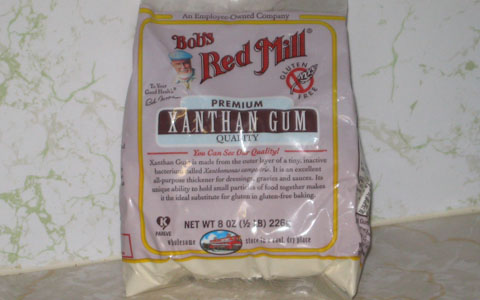
But how much, then, should I use? I Googled around and was led to start
off small—very small—with this potent ingredient. So I
carefully put xanthan gum to work in
Prototype 19,
and the results worked
out reasonably well. The batter tasted awesome, but I wanted to tweak the
stability. This adjustment, which included the amount of baking time, as
well as how much xanthan gum to use, would ultimately lead up to Prototype
21, with which I would close out this basic overhaul of 2017.
So the resulting basic cheesecake batter would now involve these
ingredients:
Cheese base (such as cottage/Neufchatel/yogurt)
Xanthan gum (supplementing whatever stabilizers were already included in
the cheese base ingredients)
Eggs
Granulated sugar
Vanilla
Compare and contrast the conventional list:
Cream cheese (with a sufficient amount of its own stabilizers,
particularly xanthan gum)
Eggs
Granulated sugar
Vanilla
Now that's very close!
In early October, not long after my overhaul efforts with my plain
prototypes, I furthermore decided to try an "egg-speriment"
(or, "eggs-experiment") with
Prototype 7 of my maple cheesecakes.
I added one
egg on top of what I primarily had been using for nearly the past two
years, i.e., I went from five eggs to six. While "one egg for every
eight ounces of cheese base" seemed to be mathematically convenient,
using a half-dozen eggs per cheesecake had a couple of advantages. One
would make my grocery shopping easier, because of the way eggs have been
packaged—typically in multiples of six (I scarcely have been using
this ingredient for any other purpose). The other would be beneficial for
the cheesecake's firmness and texture. The outcome of the maple cheesecake
itself was great, so I decided at this point to utilize the sixth egg on
a regular basis. |
An update since the COVID-19 (coronavirus) outbreak, late-2021
My
cheesecake baking took a big hiatus in 2020—and continued through
most of 2021. The last time I baked a cheesecake before this long break was
probably in late December of 2019 or sometime in January of 2020. The reason
for this stoppage was a breakout of a worldwide pandemic called COVID-19,
or the coronavirus. This extremely infamous disease resulted in massive
disruptions, including cancellations of numerous events at which I would
normally serve my well-appreciated dessert. Even when such events
resumed—or other events somehow continued on—there remained
restrictions that still hindered my bringing these cheesecakes. And I was
reluctant to make a whole cheesecake to be eaten by myself only (too many
calories on my own!).
With the upcoming Rosh HaShanah lunch in early September of 2021 at my
cousin Joanne's place marking my first time eating there since Thanksgiving
of 2019, I finally baked my very first cheesecake in nearly
20 months—Chocolate, Prototype 24.
How good it was to get back, at long
last, into making my sweet specialty this side of COVID-19! This "Head
of the Year" meal at her house would include my "Head of the
(hopefully) Post-COVID Era" cheesecakes.
During this extensive down time, I made a decision to implement a small
change, largely out of simplification, to my "cheese base". This
would now consist of equal amounts of cottage, Neufchatel and yogurt
cheeses (no other closely-related changes, such as adjusting the amount of
xanthan gum—but for which I would end up having rubbery regrets
here—would be made). Among other things, this resulted in using
one whole 16-ounce container of cottage cheese, unlike the past, when I
used one and a half containers of this for a single recipe—which
meant putting a half-used container back in the refrigerator, for some
other (hopefully near-future!) purpose. Under this latest modification,
yogurt cheese would remain at 16 ounces, but Neufchatel would be doubled,
from 8 to 16 ounces. The aforementioned chocolate prototype, rather than a
plain one, would be the debut cheesecake for this new
formulation. |
|
|

|